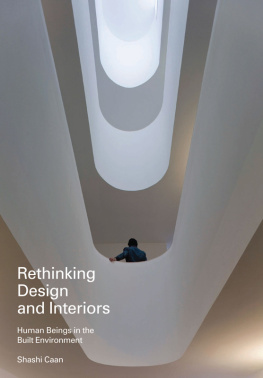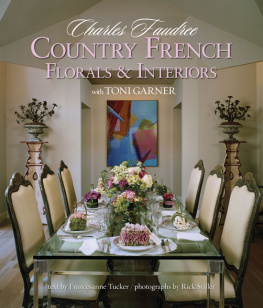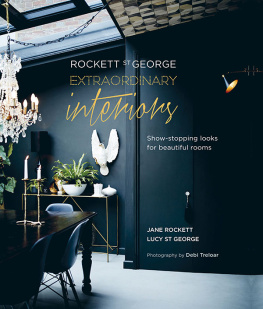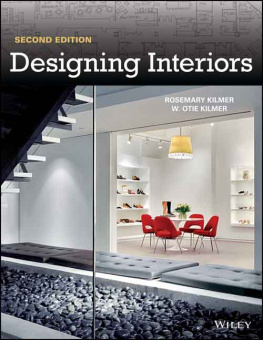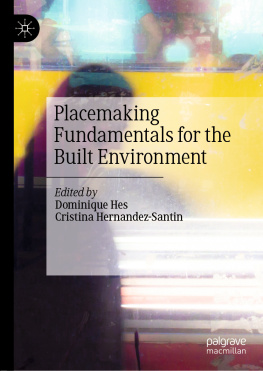Caan - Rethinking design and interiors: human beings in the built environment
Here you can read online Caan - Rethinking design and interiors: human beings in the built environment full text of the book (entire story) in english for free. Download pdf and epub, get meaning, cover and reviews about this ebook. publisher: Laurence King Publishing, genre: Romance novel. Description of the work, (preface) as well as reviews are available. Best literature library LitArk.com created for fans of good reading and offers a wide selection of genres:
Romance novel
Science fiction
Adventure
Detective
Science
History
Home and family
Prose
Art
Politics
Computer
Non-fiction
Religion
Business
Children
Humor
Choose a favorite category and find really read worthwhile books. Enjoy immersion in the world of imagination, feel the emotions of the characters or learn something new for yourself, make an fascinating discovery.
- Book:Rethinking design and interiors: human beings in the built environment
- Author:
- Publisher:Laurence King Publishing
- Genre:
- Rating:3 / 5
- Favourites:Add to favourites
- Your mark:
- 60
- 1
- 2
- 3
- 4
- 5
Rethinking design and interiors: human beings in the built environment: summary, description and annotation
We offer to read an annotation, description, summary or preface (depends on what the author of the book "Rethinking design and interiors: human beings in the built environment" wrote himself). If you haven't found the necessary information about the book — write in the comments, we will try to find it.
Caan: author's other books
Who wrote Rethinking design and interiors: human beings in the built environment? Find out the surname, the name of the author of the book and a list of all author's works by series.
Rethinking design and interiors: human beings in the built environment — read online for free the complete book (whole text) full work
Below is the text of the book, divided by pages. System saving the place of the last page read, allows you to conveniently read the book "Rethinking design and interiors: human beings in the built environment" online for free, without having to search again every time where you left off. Put a bookmark, and you can go to the page where you finished reading at any time.
Font size:
Interval:
Bookmark:
Rethinking Design and Interiors
Human Beings in the Built Environment
Shashi Caan
Laurence King Publishing

Published in 2011
by Laurence King Publishing Ltd
361373 City Road
London EC1V 1LR
Tel +44 (0)20 7841 6900
Fax +44 (0)20 7841 6910
E
www.laurenceking.com
Design copyright 2011 Laurence King Publishing Limited
Text Shashi Caan
Shashi Caan has asserted her right under the Copyright, Designs and Patents Act 1988, to be identified as the Author of this work. All rights reserved. No part of this publication may be reproduced or transmitted in any form or by any means, electronic or mechanical, including photocopy, recording or any information storage and retrieval system, without prior permission in writing from the publisher.
A catalogue record for this book is available from the British Library
ISBN 978 185669 756 9
Designed by Laura Tabet
Printed in China
PICTURE CREDITS
Front cover: Lrida University, Alvaro Siza (photo: Fernando Guerra/VIEW)
Back cover: Shashi Caan
1314 Shashi Caan; Nicolas Lescureux, Musum national dHistoire naturelle (Paris, France); 17, 18 top Theodore Prudon; 18 center & bottom Shashi Caan, after N. Schoenauer, 6,000 Years of Housing, W.W. Norton & Co., 2000; 19 top Theodore Prudon; 19 bottom Fewkes, Cave Dwellings of the Old and New World in American Anthropologist, 1910; James Orr/New Mexico Tourism Department; Carl Sofus Lumholtz, Unknown Mexico, Macmillan & Co., Ltd, 1902; 21 center National Museum and Research Center of Altamira Department of Culture of Spain; 21 bottom Theodore Prudon; Richard Shieldhouse; 23, 25 Carl Sofus Lumholtz, Unknown Mexico, Macmillan & Co., Ltd, 1902; 26 top Vitruvius, De Architectura, trans. Cesare Cesariano; 26 bottomOn Adams House in Paradise, from Viollet-le-Ducs Dictionnaire Vitruvius, De Architectura, trans. Cesare Cesariano; Marc-Antoine Laugier, Essai sur larchitecture, 1755; AIA Journal, October 1961; Diderot and dAlembert, Encyclopdie, 17511772; Francesco Colonna, Hypnerotomachia Poliphili, Venice, 1499; Shashi Caan; 4647 Shashi Caan, after Edward T. Hall, The Hidden Dimension, Anchor Books, 1990; Getty Images/Time & Life Archive, Photographer Bernard Hoffman; 49, 50 Shashi Caan; Shashi Caan, after S. Diamant, A Prehistoric Figure from Mycenae published in The Annual of the British School at Athens, Vol. 69 (1974); Shashi Caan; Librado Romero/The New York Times; Robert Fludd, Utrisque Cosmi, 1619; Modulor redrawn by Shashi Caan/FLC/ADAGP, Paris and DACS, London 2011; Shashi Caan; Albrecht Drer, Four Books on Human Proportion (Vier Bcher von Menschlicher Proportion), 15121523; Shashi Caan; Cover of the English edition of Architects Data, Ernst Neufert; Shashi Caan; Theodore Prudon; Getty Images/Time & Life Archive, Photographer Frank Scherschel; US Patent No. 324, 825 25, August 1885, reproduced in S. Giedion, Mechanization Takes Command, Oxford University Press, 1948; Courtesy of the Teylers Museum, Haarlem, Collection of M. de Clercq; Shashi Caan, after James Marston Fitch, American Building, 1948; Albrecht Drer, St. Jerome in his Study, 1514; Photography Collection, Miriam and Ira D. Wallach Division of Art, Prints and Photographs, The New York Public Library; Shashi Caan; Shashi Caan, with data from the Gallup-Healthways Well-Being Index; Diderot and dAlembert, Encyclopdie, 17511772; Elsie de Wolfe, The House in Good Taste, 1913; 9091 Catherine Ward Beecher and Harriet Beecher Stowe, American Womans Home, or Principles of Domestic Science, 1869; Germain Boffrand, Oeuvre darchitecture Paris, Pierre Patte, 1753; Library of Congress; 95 top Ezra Stoller/ESTO; 95 bottom Shashi Caan; 96 top Pullman Company, as reproduced in S. Giedion, Mechanization Takes Command, Oxford University Press, 1948; 96 bottom Walter Dorwin Teague, 1949, Courtesy of Teague, Seattle; 97 left Scott Norsworthy; 97 right Shashi Caan; 9899 Theodore Prudon; 100 left Charles Bell, The Anatomy of the Brain, 1802; 100 right Shashi Caan, as redrawn from the Proceedings of the National Academy of the Sciences of the United States of America, January 2009; Cover, American Phrenological Journal, Vol. X, No. 3, March, 1848, O. S. Fowler, ed.; Caroli Linnaei, Systema naturae: Regnum animale, 1735; J. C. Lavater, Von der Physiognomik, 1772; Shashi Caan; Galen R. Frysinger; 110111, 115, 116117, 121 Shashi Caan; The New York Public Library Archives, The New York Public Library, Astor, Lenox and Tilden Foundations; 130131 Rowena Reed Fund; 134 top Paul Jonusaitis; 134 center Foster + Partners; 134 bottom Shashi Caan; Art & Architecture Collection, Miriam and Ira D. Wallach Division of Art, Prints and Photographs, The New York Public Library, Astor, Lenox and Tilden Foundations; Shashi Caan, as redrawn with permission from Ethel Rompilla, Color for Interior Design, Harry N. Abrams, 2005; 140141 Shashi Caan; Courtesy of the Brent R. Harris Collection/The Josef and Anni Albers Foundation/VG Bild-Kunst, Bonn and Dacs, London 2011; Art & Architecture Collection, Miriam and Ira D. Wallach Division of Art, Prints and Photographs, The New York Public Library, Astor, Lenox and Tilden Foundations; 146 top Kirill Pochivalov; 146 bottom Vladimir V. Lima, Phillippines; 148149 Dunja Vrkljan; 151 top Getty Images, Photographer Mario Tama/ARS, NY and DACS, London 2011; 151 bottom Getty Images, Photographer Timothy A. Clary/ARS, NY and DACS, London 2011; 152153 Getty Images/Hulton Archive, Photographer Frank Martin/ARS, NY and DACS, London 2011; Shashi Caan, adapted from original image courtesy of Flickr user Oceandesetoiles; 156159, 161 top Shashi Caan; 161 center Theodore Prudon; 161 bottom Paul Goyette; Shashi Caan; Nicolas Lannuzel: www.flickr.com/photos/nlann; Shashi Caan; Constant Nieuwenhuys, New Babylon, Groep sectoren, 1959, Collection of the Gemeentemuseum Den Haag/DACS 2011; Shimizu Corporation; 178179 Tsui Design and Research
AUTHORS ACKNOWLEDGMENTS
The architectural truism of it takes a village to build a building very much applies to the actualization of this book. The simple yet poignant questions asked by my students inspired me to search for a deeper understanding and to investigate some of the fundamentals of both human needs and design criteria. At the end of the project,
I would like to acknowledge all those who have contributed to its completion. These contributions include many discussions, advice, research, and reviews of ideas and various versions of the manuscript. Apart from those people with whom I have interacted, there remain others who have worked to help transform the manuscript into the physical reality of a book. I express my heartfelt thanks for your effort.
As a teacher I must first and foremost thank all my students. I have learnt a great deal from them. It was their curiosity and persistent questioning of a need to understand design that forced me to seek comprehensive explanations for complex matters. The concepts in this book are born out of their quest for clarifications, and, in the process, it has enormously enriched my own comprehension.
I am grateful to Philip Cooper, Editorial Director at Laurence King Publishing, who not only encouraged me to commit these ideas to paper, but also patiently guided me through the intriguing process of writing and publishing. Indeed, my thanks go to the entire Laurence King Publishing team, who helped with the myriad aspects involved in the publication of this book. Without their support and help, my ideas would still be the subject of verbal debate.
Next pageFont size:
Interval:
Bookmark:
Similar books «Rethinking design and interiors: human beings in the built environment»
Look at similar books to Rethinking design and interiors: human beings in the built environment. We have selected literature similar in name and meaning in the hope of providing readers with more options to find new, interesting, not yet read works.
Discussion, reviews of the book Rethinking design and interiors: human beings in the built environment and just readers' own opinions. Leave your comments, write what you think about the work, its meaning or the main characters. Specify what exactly you liked and what you didn't like, and why you think so.

